
Levitating a coil
Tesladownunder, Sun May 14 2006, 10:53AMWas reorganising my web site and looking at magnetic levitation stuff so thought I'd try a few things.
Here is an air cored coil out of a defibrillator output circuit. Don't know number of turns but the inductance is 10mH (I think). It is drawing 6.5 A at 100V AC to get the lift of about 1/2 inch off a 1/4 inch copper plate. It is tethered like a conventional lifter.
I did try levitating a MOT with the E section opened and facing down but really needed a better winding. Hence I tried a non cored coil.
Peter
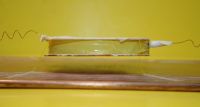

Re: Levitating a coil
uzzors2k, Sun May 14 2006, 11:20AM
Nice. Have you tried lifting anything with it?
uzzors2k, Sun May 14 2006, 11:20AM
Nice. Have you tried lifting anything with it?
Re: Levitating a coil
Marko, Sun May 14 2006, 11:22AM
Always cool ideas from you!
I wonder if it could be stabilised using more than one coil, or fed with higher frequency current for more power.
Good work!
Marko, Sun May 14 2006, 11:22AM
Always cool ideas from you!

I wonder if it could be stabilised using more than one coil, or fed with higher frequency current for more power.
Good work!
Re: Levitating a coil
Tesladownunder, Sun May 14 2006, 06:37PM
Here is the 284g coil lifting a 217g solder reel (total 500g). Current was a bit higher and distance off the base was 1/4 inch compared with 1/2 inch before. There is a world of difference with an electrostatic lifter where the lift is (mostly) independent of the proximity of the ground and is far smaller.
Peter
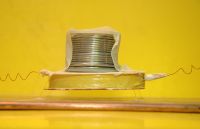
Tesladownunder, Sun May 14 2006, 06:37PM
uzzors wrote ...
Nice. Have you tried lifting anything with it?
Nice. Have you tried lifting anything with it?
Here is the 284g coil lifting a 217g solder reel (total 500g). Current was a bit higher and distance off the base was 1/4 inch compared with 1/2 inch before. There is a world of difference with an electrostatic lifter where the lift is (mostly) independent of the proximity of the ground and is far smaller.
Peter

Re: Levitating a coil
stop4stuff, Sun May 14 2006, 07:33PM
very nice Peter,
I think i got a bit of an understanding why this works... something to do with eddy currents in the base copper plate? what i'm trying to get my head around is the AC, DC thru a coil would make the coil an electromagnet and it would repell off a magnet giving lfit, but AC? Does the base plate have a repelling magnetic force because of eddy currents induced by the coil? if so would a ring shaped base plate (same shape as the coil) give a better lift for less power?
intrigued,
paul
stop4stuff, Sun May 14 2006, 07:33PM
very nice Peter,
I think i got a bit of an understanding why this works... something to do with eddy currents in the base copper plate? what i'm trying to get my head around is the AC, DC thru a coil would make the coil an electromagnet and it would repell off a magnet giving lfit, but AC? Does the base plate have a repelling magnetic force because of eddy currents induced by the coil? if so would a ring shaped base plate (same shape as the coil) give a better lift for less power?
intrigued,
paul
Re: Levitating a coil
uzzors2k, Sun May 14 2006, 08:07PM
Thats impressive! It can nearly lift its own weight!
I thought the coil was levitating because the copper is diamagnetic?
uzzors2k, Sun May 14 2006, 08:07PM
Thats impressive! It can nearly lift its own weight!

I thought the coil was levitating because the copper is diamagnetic?
Re: Levitating a coil
Marko, Sun May 14 2006, 08:13PM
Just a simple eddy-current induction repelling.
Marko, Sun May 14 2006, 08:13PM
Just a simple eddy-current induction repelling.
Re: Levitating a coil
stop4stuff, Sun May 14 2006, 08:23PM
could be diamagnetism, copper is slightly diamagnetic
i've got a kilo of bismuth shot around somewhere (bismuth is 15x more diamagnetic than copper)... something to try tomorrow :)
stop4stuff, Sun May 14 2006, 08:23PM
could be diamagnetism, copper is slightly diamagnetic

i've got a kilo of bismuth shot around somewhere (bismuth is 15x more diamagnetic than copper)... something to try tomorrow :)
Re: Levitating a coil
..., Sun May 14 2006, 09:22PM
It actually wouldn't surprise me if it is diamagnetism, but with ac I am pretty sure it is eddy currents
I have a superconductor puck... perhaps I should try to rig up some coils to play with the next time my dad brings the LN2 XD
..., Sun May 14 2006, 09:22PM
It actually wouldn't surprise me if it is diamagnetism, but with ac I am pretty sure it is eddy currents

I have a superconductor puck... perhaps I should try to rig up some coils to play with the next time my dad brings the LN2 XD
Re: Levitating a coil
Alessandro, Sun May 14 2006, 09:26PM
It not diamagnetism as the most diamagnetic material on Earth (pyrolytic graphite) can only float mere millimeters above grade N50 neodymium super magnets and barely lifts its own weight.
It is eddy current repulsion from AC being feed to the coil.
Care to give more infomation on this TDU? frequency? power?
whoops, I read though the posts quickly and missed that part ^^
Alessandro, Sun May 14 2006, 09:26PM
It not diamagnetism as the most diamagnetic material on Earth (pyrolytic graphite) can only float mere millimeters above grade N50 neodymium super magnets and barely lifts its own weight.
It is eddy current repulsion from AC being feed to the coil.
Care to give more infomation on this TDU? frequency? power?
whoops, I read though the posts quickly and missed that part ^^
Re: Levitating a coil
Marko, Sun May 14 2006, 09:39PM
100VAC, at probably 50Hz and 6,5A (650W).
Marko, Sun May 14 2006, 09:39PM
It is eddy current repulsion from AC being feed to the coil, care to give more infomation on this TDU? frequency? power?
100VAC, at probably 50Hz and 6,5A (650W).
Re: Levitating a coil
..., Sun May 14 2006, 11:05PM
Actually the most diamagnet substance is any of the superconductors... They exhibit enough superdiamagnetism to levatate the magnet above the superconductor
In any case, if we can levate a frog from the diamagnetism of the water? in it...
..., Sun May 14 2006, 11:05PM
Alessandro wrote ...
It not diamagnetism as the most diamagnetic substance on Earth (pyrolytic graphite) can only float mere millimeters above grade N50 neodymium super magnets and barely lifts its own weight.
It is eddy current repulsion from AC being feed to the coil, care to give more infomation on this TDU? frequency? power?
It not diamagnetism as the most diamagnetic substance on Earth (pyrolytic graphite) can only float mere millimeters above grade N50 neodymium super magnets and barely lifts its own weight.
It is eddy current repulsion from AC being feed to the coil, care to give more infomation on this TDU? frequency? power?
Actually the most diamagnet substance is any of the superconductors... They exhibit enough superdiamagnetism to levatate the magnet above the superconductor

In any case, if we can levate a frog from the diamagnetism of the water? in it...
Re: Levitating a coil
Maz, Sun May 14 2006, 11:51PM
now how plausible would it be to make something that wasnt tethered?
the power supply and a source of batteries on the coil.
this wouldnt do it, but i wonder what could????
Maz, Sun May 14 2006, 11:51PM
now how plausible would it be to make something that wasnt tethered?
the power supply and a source of batteries on the coil.
this wouldnt do it, but i wonder what could????

Re: Levitating a coil
G^3, Sun May 14 2006, 11:53PM
Next time you get some liquid nitrogen cool the copper way down. In my physics class there was a demo with a supercold copperplate and a magnet and you could drop the magnet and it would bounce, with out touching the plate, and then slowly settle down. I bet if the copper plate was very cold the coil could lift way over its own weight.
G^3, Sun May 14 2006, 11:53PM
Next time you get some liquid nitrogen cool the copper way down. In my physics class there was a demo with a supercold copperplate and a magnet and you could drop the magnet and it would bounce, with out touching the plate, and then slowly settle down. I bet if the copper plate was very cold the coil could lift way over its own weight.
Re: Levitating a coil
Tesladownunder, Mon May 15 2006, 12:50AM
I found this copper plate in a scrap metal yard and I think it cost some AUD$20 for the copper weight but I knew it would be great for magnetic repulsion stuff.
It is really interesting to watch a NIB magnet slide down this in slow motion when it is held at a 70degree slope just by the action of eddy currents. It takes perhaps 10 seconds to reach the bottom. Similarly if you try to slide the magnet over the copper it gives a lot of rate dependent resistance. This is a real force measured in kg and way above any para/diamagnetic force measured in mg. The simple test is to see if it works with DC (it doesn't).
Although it can lift its own weight there is a huge power requirement which is one of the reasons that we still use wheels on our SUV's. To get 650W out of a battery plus an inverter to give AC would be a challenge if limited to 200g.
I have two of these coils which will fit on the plate. I might try them together which should make them stable in 2 dimensions. I figure only 2 support strings will be needed then which can be the input wires.
A question: My setup was on my table with an iron frame. Would this make a difference through the copper plate in this setup?
Peter
Tesladownunder, Mon May 15 2006, 12:50AM
G^3 wrote ...
.. In my physics class there was a demo with a supercold copperplate and a magnet and you could drop the magnet and it would bounce, with out touching the plate, and then slowly settle down. ...
What you saw in your physics class was a magnet dropped onto a superconductor, not copper. A superconductor repels a magnetic field (perfect conductor = perfect eddy currents to repel). A stationary magnet will not levitate above a stationary plate since no eddy currents are generated... In my physics class there was a demo with a supercold copperplate and a magnet and you could drop the magnet and it would bounce, with out touching the plate, and then slowly settle down. ...
I found this copper plate in a scrap metal yard and I think it cost some AUD$20 for the copper weight but I knew it would be great for magnetic repulsion stuff.
It is really interesting to watch a NIB magnet slide down this in slow motion when it is held at a 70degree slope just by the action of eddy currents. It takes perhaps 10 seconds to reach the bottom. Similarly if you try to slide the magnet over the copper it gives a lot of rate dependent resistance. This is a real force measured in kg and way above any para/diamagnetic force measured in mg. The simple test is to see if it works with DC (it doesn't).
Although it can lift its own weight there is a huge power requirement which is one of the reasons that we still use wheels on our SUV's. To get 650W out of a battery plus an inverter to give AC would be a challenge if limited to 200g.
I have two of these coils which will fit on the plate. I might try them together which should make them stable in 2 dimensions. I figure only 2 support strings will be needed then which can be the input wires.
A question: My setup was on my table with an iron frame. Would this make a difference through the copper plate in this setup?
Peter
Re: Levitating a coil
Simon, Mon May 15 2006, 01:14AM
Anyone who's still confused about the physics of this should look up Lenz's Law. It's the simplest way to qualitatively understand this sort of stuff.
EM isn't my best field yet, but my guess to your question, TDU, is that the iron bench won't have a significant effect.
Simon, Mon May 15 2006, 01:14AM
Anyone who's still confused about the physics of this should look up Lenz's Law. It's the simplest way to qualitatively understand this sort of stuff.
EM isn't my best field yet, but my guess to your question, TDU, is that the iron bench won't have a significant effect.
Re: Levitating a coil
Dr. Slack, Mon May 15 2006, 07:14AM
Nice demonstration Peter
The discussion about diamagnetism - with AC, the copper is effectively diamagnetic, the eddy currents induced in it reduce the field in the material. This only works at DC in superconductors.
Perhaps somebody could look up the skin depth for copper at 50Hz, this is the distance through the copper at which the field has reduced to 1/e (my gut feel thinks it's a few mm, how good is my guess?) A sheet of copper several skin depths thick would prevent any significant field penetrating to the other side (this answers the iron bench question)
That 100v x 6.5A is not 650W of course, but 650VA. The actual power dissipated in the coil will be given through the DC resistance of the coil (at operating temperature) by I[sup]2[/sup]R. A measurement of true electrical power consumed at the terminals would give the heating in the copper plate as well as the heating in the coil. Not having a watt meter, I usually make that measurement by substituting various power factor correction capacitors across the input terminals to resonate out the reactive current, until I get a minimum recorded current, which is the resistive current.
How long can you run it before that interesting smell prompts you to turn it off?
Dr. Slack, Mon May 15 2006, 07:14AM
Nice demonstration Peter
The discussion about diamagnetism - with AC, the copper is effectively diamagnetic, the eddy currents induced in it reduce the field in the material. This only works at DC in superconductors.
Perhaps somebody could look up the skin depth for copper at 50Hz, this is the distance through the copper at which the field has reduced to 1/e (my gut feel thinks it's a few mm, how good is my guess?) A sheet of copper several skin depths thick would prevent any significant field penetrating to the other side (this answers the iron bench question)
That 100v x 6.5A is not 650W of course, but 650VA. The actual power dissipated in the coil will be given through the DC resistance of the coil (at operating temperature) by I[sup]2[/sup]R. A measurement of true electrical power consumed at the terminals would give the heating in the copper plate as well as the heating in the coil. Not having a watt meter, I usually make that measurement by substituting various power factor correction capacitors across the input terminals to resonate out the reactive current, until I get a minimum recorded current, which is the resistive current.
How long can you run it before that interesting smell prompts you to turn it off?
Re: Levitating a coil
Bored Chemist, Mon May 15 2006, 08:03AM
Just a thought; one way of looking at diamagnetism is that it's the effect of eddy currents on the atomic level. Because (classicly) the electrons are orbiting already the diamagnetic effect still works with DC.
I'd still be interested in knowing the effect of cooling the coil and plate in liquid nitrogen. Dropping the resistance roughly 4-fold should make some difference
Bored Chemist, Mon May 15 2006, 08:03AM
Just a thought; one way of looking at diamagnetism is that it's the effect of eddy currents on the atomic level. Because (classicly) the electrons are orbiting already the diamagnetic effect still works with DC.
I'd still be interested in knowing the effect of cooling the coil and plate in liquid nitrogen. Dropping the resistance roughly 4-fold should make some difference
Re: Levitating a coil
ragnar, Mon May 15 2006, 08:27AM
Skin depth in copper at 50Hz-60Hz is 8mm-9mm, depending on where you live...
C'mon dude, square-root of all rho on pi times F times mu. =)
ragnar, Mon May 15 2006, 08:27AM
Skin depth in copper at 50Hz-60Hz is 8mm-9mm, depending on where you live...
C'mon dude, square-root of all rho on pi times F times mu. =)
Re: Levitating a coil
stop4stuff, Mon May 15 2006, 10:43AM
A little bit of research later...
Also works with aluminium
A maglev train uses the same technology - 3 phase electromagnets on the train induces repelling magnetic fields in aluminium tracks, the 3 phase provides a 'magnetic ripple' propelling the train along.
stop4stuff, Mon May 15 2006, 10:43AM
A little bit of research later...
Also works with aluminium

A maglev train uses the same technology - 3 phase electromagnets on the train induces repelling magnetic fields in aluminium tracks, the 3 phase provides a 'magnetic ripple' propelling the train along.
Re: Levitating a coil
Marko, Mon May 15 2006, 11:24AM
Actually it seems that quite a bit of power is dissipated in a copper plate because of srong eddy currents.
Marko, Mon May 15 2006, 11:24AM
That 100v x 6.5A is not 650W of course, but 650VA. The actual power dissipated in the coil will be given through the DC resistance of the coil (at operating temperature) by I[sup]2[/sup]R. A measurement of true electrical power consumed at the terminals would give the heating in the copper plate as well as the heating in the coil.
Actually it seems that quite a bit of power is dissipated in a copper plate because of srong eddy currents.
Re: Levitating a coil
Tesladownunder, Mon May 15 2006, 04:29PM
Well, sounds like time to pull out the kW meter.
Readings below are 100.6V, 6.61 A (giving 665 VA)
Power meter shows 0.55kW (550W).
I presume this is a power factor of 0.82.
I guess it would be less without the load of the copper plate with the more pure inductance.
I'm sure a clever person could work out using the specific heat of copper, how long it would take to raise the temperature of the 200g work coil to 220C from 20C given a total power input of 550 W with perhaps 30% (a guess) being transferred to the copper plate and not contributing to coil heating. Who will be the first to do so. I would guess 60 seconds.
Peter
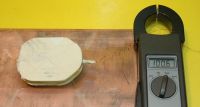
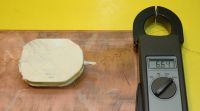
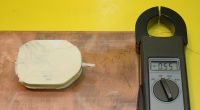
Tesladownunder, Mon May 15 2006, 04:29PM
Well, sounds like time to pull out the kW meter.
Readings below are 100.6V, 6.61 A (giving 665 VA)
Power meter shows 0.55kW (550W).
I presume this is a power factor of 0.82.
I guess it would be less without the load of the copper plate with the more pure inductance.
NeilThomas wrote ...
How long can you run it before that interesting smell prompts you to turn it off?
Lots of 2-3 second shots to get 20 - 30 photos. Took a few breaks to allow it to cool. Never got to the interesting smell stage.How long can you run it before that interesting smell prompts you to turn it off?
I'm sure a clever person could work out using the specific heat of copper, how long it would take to raise the temperature of the 200g work coil to 220C from 20C given a total power input of 550 W with perhaps 30% (a guess) being transferred to the copper plate and not contributing to coil heating. Who will be the first to do so. I would guess 60 seconds.
Peter



Re: Levitating a coil
Marko, Mon May 15 2006, 08:59PM
I think it would take somewhat more for th e power to corrupt this coil.
Maybe few minutes.
I think you need to figure out power dissipated in the copper plate more accurately, does it get warm and how much..?
Marko, Mon May 15 2006, 08:59PM
I think it would take somewhat more for th e power to corrupt this coil.
Maybe few minutes.
I think you need to figure out power dissipated in the copper plate more accurately, does it get warm and how much..?
Re: Levitating a coil
Tesladownunder, Tue May 16 2006, 12:16AM
OK here is a 30 second test.
Power was 540W dropping to 470W during the test.
Coil temperature rose from 22.4C to 108C peak about 10 secs after the test
Copper plate temp rose from 22.4 to 24.6C
Copper plate is 6mm x 254mm x 160mm
I should repeat this test with the coil thermally insulated from the plate but have to let it cool first.
External temperature rose 80C in 30 secs so 220C should be reached in less than 90 secs even allowing for increasing resistance and reducing power. The core temp would be expected to be even higher than the external temp though.
I will alter this post when I get to repeat it insulated but feel free to calculate the energy transfer from these data as they should be close.
Peter
Tesladownunder, Tue May 16 2006, 12:16AM
OK here is a 30 second test.
Power was 540W dropping to 470W during the test.
Coil temperature rose from 22.4C to 108C peak about 10 secs after the test
Copper plate temp rose from 22.4 to 24.6C
Copper plate is 6mm x 254mm x 160mm
I should repeat this test with the coil thermally insulated from the plate but have to let it cool first.
External temperature rose 80C in 30 secs so 220C should be reached in less than 90 secs even allowing for increasing resistance and reducing power. The core temp would be expected to be even higher than the external temp though.
I will alter this post when I get to repeat it insulated but feel free to calculate the energy transfer from these data as they should be close.
Peter
Re: Levitating a coil
Simon, Tue May 16 2006, 01:10AM
Your blatant manipulation of board members has worked.
The specific heat capacitor of copper is 385J/kg/K. So raising .2kg of copper by 200C takes 385x200x.2 J = 15400J of energy. 550W at 70% efficiency is 385W, so dividing again by 385 gives 40s.
That's a lower bound, since heat radiation will make it take longer.
Simon, Tue May 16 2006, 01:10AM
Tesladownunder wrote ...
I'm sure a clever person could work out using the specific heat of copper, how long it would take to raise the temperature of the 200g work coil to 220C from 20C given a total power input of 550 W with perhaps 30% (a guess) being transferred to the copper plate and not contributing to coil heating. Who will be the first to do so. I would guess 60 seconds.
I'm sure a clever person could work out using the specific heat of copper, how long it would take to raise the temperature of the 200g work coil to 220C from 20C given a total power input of 550 W with perhaps 30% (a guess) being transferred to the copper plate and not contributing to coil heating. Who will be the first to do so. I would guess 60 seconds.
Your blatant manipulation of board members has worked.

The specific heat capacitor of copper is 385J/kg/K. So raising .2kg of copper by 200C takes 385x200x.2 J = 15400J of energy. 550W at 70% efficiency is 385W, so dividing again by 385 gives 40s.
That's a lower bound, since heat radiation will make it take longer.
Re: Levitating a coil
Tesladownunder, Tue May 16 2006, 05:30AM
Oooh.. Spooky coincidence with the 385's.
Now can a clever person calculate the power loss to the plate from the second set of figures?
Peter
Tesladownunder, Tue May 16 2006, 05:30AM
Oooh.. Spooky coincidence with the 385's.
Now can a clever person calculate the power loss to the plate from the second set of figures?
Peter
Re: Levitating a coil
teravolt, Tue May 16 2006, 05:34AM
Very neet Tesla Downunder I have seen disks of aluminuim levitated in this manor with field shaping.
teravolt, Tue May 16 2006, 05:34AM
Very neet Tesla Downunder I have seen disks of aluminuim levitated in this manor with field shaping.
Re: Levitating a coil
Marko, Tue May 16 2006, 05:24PM
Could you try to hook the coil up to a flyback core driven by andrineri driver?

Marko, Tue May 16 2006, 05:24PM
Could you try to hook the coil up to a flyback core driven by andrineri driver?

Re: Levitating a coil
Tesladownunder, Wed May 17 2006, 12:42PM
Average input power = 500W
Total energy input in 30 sec is 15000J
Mass of copper plate is 9g/cc x 243 cc = 2.2kg
Temp rise of copper plate is 2.2C
Energy to raise 2.2kg by 2.2C is 385 x 2.2 x 2.2 = 1800J
Hence power transfer is 1800/15000 = 12%
Less than I thought but this will vary with the weight supported and how closely it is tethered.
Power remaining in the coil similarly is 385 x 0.25 x 86 = 8300J
(put weight as 250g copper)
Total energy accounted for by temp rise is 1800 + 8300 = 10100J which is less than the calculated input of 15000J. Presumably the difference is due to factors like air cooling and also the core of the copper coil is probably a lot hotter than 108 degrees. In fact, there would be energy balance at 126C.
Peter
Tesladownunder, Wed May 17 2006, 12:42PM
Tesladownunder wrote ...
OK here is a 30 second test.
Power was 540W dropping to 470W during the test.
Coil temperature rose from 22.4C to 108C peak about 10 secs after the test
Copper plate temp rose from 22.4 to 24.6C
Copper plate is 6mm x 254mm x 160mm
Ok, no takers so here are the calculations.OK here is a 30 second test.
Power was 540W dropping to 470W during the test.
Coil temperature rose from 22.4C to 108C peak about 10 secs after the test
Copper plate temp rose from 22.4 to 24.6C
Copper plate is 6mm x 254mm x 160mm
Average input power = 500W
Total energy input in 30 sec is 15000J
Mass of copper plate is 9g/cc x 243 cc = 2.2kg
Temp rise of copper plate is 2.2C
Energy to raise 2.2kg by 2.2C is 385 x 2.2 x 2.2 = 1800J
Hence power transfer is 1800/15000 = 12%
Less than I thought but this will vary with the weight supported and how closely it is tethered.
Power remaining in the coil similarly is 385 x 0.25 x 86 = 8300J
(put weight as 250g copper)
Total energy accounted for by temp rise is 1800 + 8300 = 10100J which is less than the calculated input of 15000J. Presumably the difference is due to factors like air cooling and also the core of the copper coil is probably a lot hotter than 108 degrees. In fact, there would be energy balance at 126C.
Peter
Re: Levitating a coil
Tesladownunder, Sun May 21 2006, 04:29AM
Invoking the double post rules of 48h with new information here.
Two pics. One shows double coils elevating with only 2 support wires plus the effect of a large iron mass beneath it (none). Second shows the 2 coil setup and the 1.3kW to drive it.
Peter
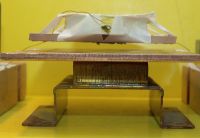

Tesladownunder, Sun May 21 2006, 04:29AM
Invoking the double post rules of 48h with new information here.
Two pics. One shows double coils elevating with only 2 support wires plus the effect of a large iron mass beneath it (none). Second shows the 2 coil setup and the 1.3kW to drive it.
Peter


Print this page